A
walk through Verona
The Arena
(Roman Arena) dominates the
bustling Piazza Bra'.
It was built in the 1st Century A.D. and it is one of the most important
and best preserved Roman amphitheatres (the 3rd largest one in existence).Nowadays
in the Arena, which can hold up to 22,000 people, world famous operas are
performed every summer. It is in pink marble and remarkably well preserved,
despite a 12th Century earthquake that destroyed most of its outer wall.
Casa Di Giulietta
Along Via
Mazzini, Verona's main shopping street, is
Via Cappello and
"Juliet's House" at No 23. Romeo and Juliet may have been fictional, but
here you can swoon beneath what popular myth says was her balcony
or, if in need of a new lover, approach a bronze statue of Juliet and rub
her left breast for good luck. It is even doubtful there was ever a feud
between the Capuleti and Montecchi, on whom Shakespeare based the play.
You could also search out Juliet's tomb
(Via del Pontiere 5) or Romeo's house
(Via Arche Scaligere 4).
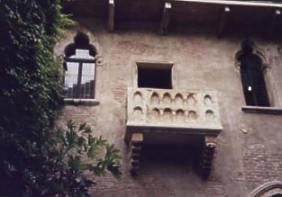 Juliet's balcony
Piazza delle
Erbe is the old Roman Forum;
today, as in the past, the colourful and picturesque market enlivens the
square. The square is lined with some of Verona's most sumptuous buildings,
including the baroque Palazzo Maffei
with the adjoining 14th Century Torre del
Gardello (Gardello Tower). On the east side
is Casa Mazzanti,
a former della Scala family residence whose fresco-decorated façade(XVI
Century) stands out.To the right of the square is the medieval Palazzo
del Comune (Palace of the Commune)dominated
by the 12th Century Torre dei Lamberti
(Lamberti Tower)(83m). In the centre of the square Madonna
Verona's fountain, built by Cansignorio della
Scala, stands out among the stalls.
Juliet's balcony
Piazza delle
Erbe is the old Roman Forum;
today, as in the past, the colourful and picturesque market enlivens the
square. The square is lined with some of Verona's most sumptuous buildings,
including the baroque Palazzo Maffei
with the adjoining 14th Century Torre del
Gardello (Gardello Tower). On the east side
is Casa Mazzanti,
a former della Scala family residence whose fresco-decorated façade(XVI
Century) stands out.To the right of the square is the medieval Palazzo
del Comune (Palace of the Commune)dominated
by the 12th Century Torre dei Lamberti
(Lamberti Tower)(83m). In the centre of the square Madonna
Verona's fountain, built by Cansignorio della
Scala, stands out among the stalls.
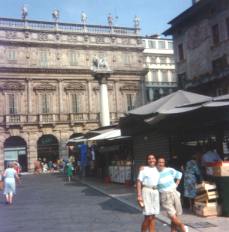 Piazza delle Erbe
Piazza delle Erbe
Separating
Piazza delle Erbe from Piazza dei Signori
is the Arco
della Costa (Costa's Arch), beneath which
is suspended a whale's rib. Legend says it will fall on the first "just"
person to walk beneath.In several centuries, it has never fallen, not even
on the various popes who have paraded beneath it. In Piazza dei Signori,
the 15th Century Loggia del Consiglio,
the former city council building, is regarded as Verona's first Renaissance
structure. It is attached to the Palazzo degli
Scaligeri, once the main residence of della
Scala family. A smaller arch links the Palazzo
del Capitano, another Scaligeri palace, to
the Palazzo del Comune: through the arch you enter the Old Market Yard
(Cortile Mercato Vecchio),
where the two-flight gothic stairs (Scala
della Ragione) is well worth seeing. Back
to Piazza dei Signori, at the far end, are the Arche Scaligere, the impressive
Scaligeri graves erected on the grounds od St.Maria Antica's church.
Ponte Pietra
: the bridge was erected in the 1st century A.D. and restored by the Scaligery
family; destroyed during the Second World War, it was then rebuilt partly
using the original material. On the other side of the bridge you can admire
another masterpiece of Roman architecture, the Teatro
Romano (Roman Theatre), dating
back to the 1st Century B.C. The remains of the theatre were discovered
in the IXI Century buried beneath some civil and religious buildings. What
you can see now, after a thorough restoration, is only a part of the original
building, which included, apart from the steps, a beautifully architectured
stage-set by the river. The theatre it is still used today, during summer,
for concerts and plays. On
a hill high behind the theatre is the Castel
San Pietro, built by the Austrians
onthe site of an earlier castle. From here you can enjoy a beautiful view
of Verona.
 around the city centre
Duomo (the
Cathedral): it was built in the XII Century on top of a pre-existing medieval
church and was then altered and enlarged during the XV and XVI Centuries.
In its façade romanesque and gothic elements blend harmoniously.
Particularly interesting is the main portal with its romanesque porch.
Inside, among other masterpieces, Titian's "Assunta"(1535) can be admired.
around the city centre
Duomo (the
Cathedral): it was built in the XII Century on top of a pre-existing medieval
church and was then altered and enlarged during the XV and XVI Centuries.
In its façade romanesque and gothic elements blend harmoniously.
Particularly interesting is the main portal with its romanesque porch.
Inside, among other masterpieces, Titian's "Assunta"(1535) can be admired.
Chiesa di
Sant'Anastasia (St.Anastasia's
church): it is the largest church in the city, built by Dominican Friars
between the XIV and the XV Century on top of a pre-existing church dedicated
to the saint. Only the portal and the lower part of the façade were
completed. The inside is gothic and contains a number of works of art,
especially medieval ones.One of the most famous frescoes is by Pisanello
"San Giorgio e la Principessa (St.George and the Princess) (1436-1438).
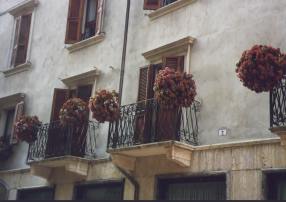 along Corso Porta Borsari
along Corso Porta Borsari
Walking
back towards Piazza delle Erbe along Corso
S.Anastasia and then further on along Corso
Porta Borsari you can see Porta
Borsari (the Borsari Gate) in
the background. Jupiter's Gate (Porta di Giove) was the original name of
this gate, which together with Porta
dei Leoni (the Lions' Gate)
were the main entrances to the Roman city. Roman gates were actual buildings
with a central courtyard; the stone facing of the façade is all
that remains today of the original building. The later name "Borsari" comes
from the latin "bursarii", i.e. the excise men who used to work here.
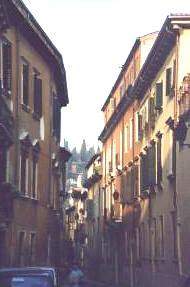 around the city centre
From
Porta Borsari you walk along Corso Cavour
to Castelvecchio
(the Old Castle). Just before reaching Castelvecchio on the right the Arco
dei Gavi (Gavi Arch)stands in
a small square. Originally built in Roman times by the architect L.Vitruvio
Cerdone for a wealthy Roman family, it was located not far from here, on
the main road. It was demolished by the French troops in 1796 and was rebuilt
only in 1930.
around the city centre
From
Porta Borsari you walk along Corso Cavour
to Castelvecchio
(the Old Castle). Just before reaching Castelvecchio on the right the Arco
dei Gavi (Gavi Arch)stands in
a small square. Originally built in Roman times by the architect L.Vitruvio
Cerdone for a wealthy Roman family, it was located not far from here, on
the main road. It was demolished by the French troops in 1796 and was rebuilt
only in 1930.
The
Castle is the largest and most impressive of the Scaligeri buildings, constructed
towards the end of their rule, when the family began to doubt the city's
loyalty. The fortress, on the banks of the Adige River, was damaged
by bombing during the WWII and restored in the 1960s. It now houses a museum
( Museo di Castelvecchio)
with a diverse collection of paintings, frescoes, jewellery and medieval
artefacts. Among the paintings are works by Pisanello, Giovanni Bellini,
Tiepolo, Carpaccio, Veronese.
The
Ponte Scaligero
spanning the Adige River was rebuilt after being destroyed by WWII bombing.
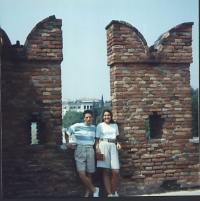
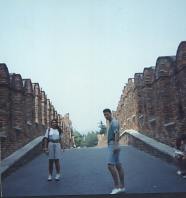 Ponte Scaligero
Ponte Scaligero
Basilica di
San Zeno Maggiore (St.Zeno's
Church) is one of the most beautiful and most important churches in Italy
and a masterpiece of Romanesque architecture. This church in honour
of the city's patron saint was built mainly in the 12th Century, although
its apse was rebuilt in the 14th Century and its bell tower, a relic of
an earlier structure on the site, was started in 1045. The portal, clad
with bronze panels, is a masterpiece of medieval European sculpture: it
is made up of 48 panels representing scenes from the Old and New Testament
and episodes from St.Zeno's life. The highlight inside is Mantegna's triptych
of the "Madonna and Saints", above the high altar.
*
Previous * Next*
Back To Verona
*
EARTH *
SKY *
WATER *
FIRE *







